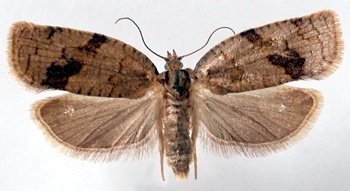Pests
Choristoneura diversana Huebner - Straw Tortrix
Systematic position.
Class Insecta, order Lepidoptera, family Tortricidae, subfamily Tortricinae, tribe Archipini, genus Choristoneura.Synonym.
Tortrix diversana Hbn.Biological group.
Polyphagous pest of fruit crops .Morphology and biology.
Sexual dimorphism. Forewing almost equally as wide as its length; somewhat projecting from above outer margin, which is simple in male and hardly concave in female (wingspan 15-20 mm in male, 19-23 mm in female). Costal band absent. Background of male wing is brownish, with a mixture of yellowish or gray color, weakly cross-striated. Wing pattern darker in comparison with background, usually brownish. Basal spot is reduced. Median band usually interrupted just before middle; subapical spot usually small, often connected to middle part of the band. Fringe the same color as background, brownish at tornus. Hindwings brownish-gray with light fringe. Female usually more olive-brown with darker pattern and more pronounced cross striation and with larger subapical spot. Basal spot disappearing in males, often well expressed in females; its color varies from cream-brown to brownish. Egg appears greenish. Caterpillar light green or brownish-green, with light or dark brown warts. Color of its head varies from brown to red-brown. Pupa blackish-brown, 11-12 mm in length. Caterpillars of 1st instar winter in small cocoons on branches in bark crevices. In the spring they renew feeding, penetrating into blossoming buds, later feeding within rolled or turned leaf shoot tips. Pupation occurs in areas of caterpillar feeding. The period of pupal development lasts 9-15 days. Moths lay eggs in batches, 25-100 eggs in a batch on upper surface of leaves, less often on branches. In autumn, hatching caterpillars creep away or are carried by wind. They sometimes skeletonize leaves until wintering.Distribution.
Tanspalearctic area. The species occurs in Middle and Southern Europe, Iran, Mongolia, Asia Minor, Northern China, Korea, Japan. In the former USSR, it is distributed in the European part (except for the north and southeast), including Ukraine (Polesye and forest-steppe zone), the Caucasus, the south of Siberia (sporadically), the Far East (Khabarovsk and Primorskii Territories, Amur and Sakhalin Regions, Southern Kuriles).Ecology.
The species is confined to steppe and wood zones. The pest is monovoltine, developing in one generation. Caterpillars renew feeding from the end of April or beginning of May and finish feeding in July. Moths fly from mid-June until the end of July in twilight and nighttime. Eggs are laid in July and August. Polyphagous caterpillars feed on several dozen species of plants. Main parasites belong to hymenopteran families Ichneumonidae and Braconidae, to flies of the family Tachinidae.Economic significance.
This is a noticeable pest of orchards and parks in the middle belt of the European part of the former USSR and in Primorskii Territory. It damages rosaceous fruiters and bushes in orchards, such as apple, pear, plum, cherry, apricot, hawthorn, raspberry, rose and Schizandra. In parks and forests, caterpillars develop on oak, beech, birch, alder, willow, poplar, buckthorn, elm, ash tree, lilacs, honeysuckle, and coniferous plants. In the south of Primorskii Territory they were marked on lespedeza, rhododendron, jasmine (Philadelphus sp.). Caterpillars were also met on fodder leguminous grasses, such as clover, alfalfa, vetch, melilot, yarrow. Mass reproduction of the leafroller is especially noticeable on flood lands. Control measures: Agronomical ones include cutting of old and diseased branches. Biological measures include application of biological preparations. Chemical ones are insecticide treatments in spring after bud blossoming (red buds status) for destruction of overwintered caterpillars in areas populated with the pest. Monitoring is possible by use of sex pheromone traps.Reference citations:
Kostyuk, Yu.A. 1974. Family Tortricidae. In: Vasil.ev, V.P., ed. Pests of agricultural crops and forest plantations. V.2. Arthropods. Kiev: Urozhai, p. 261-320 (in Russian).Kostyuk, Yu.A. 1980. Tortricidae. Iss. 10. Tortricinae. In: Dolin V.G., ed. Fauna of Ukraine, V. 15. Kiev: Naukova dumka. 424 p. (in Ukrainian).
Kuznetsov, V.I. 1994. Family Tortricidae. In: Kuznetsov, V.I., ed. Insects and mites . pests of agricultural plants. V. 3(1). Lepidoptera. St.Petersburg: Nauka, p. 51-234 (in Russian).
Kuznetsov, V.I. 2001. Family Tortricidae (Olethreutidae). In: Ler, P.A., ed. Keys to the insects if the Russian Far East. V. 5(3). Trichoptera and Lepidoptera. Vladivostok: Dal.nauka, p. 11-472 (in Russian).


